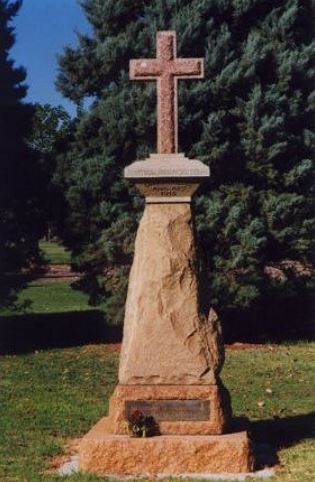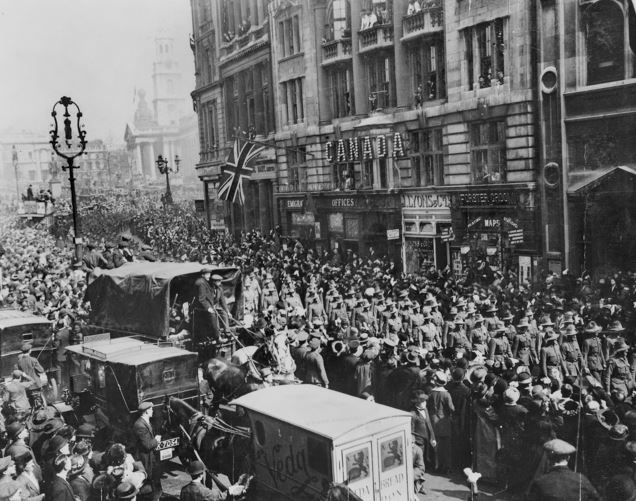In 2020 The Cove published 'A Brief History of ANZAC Day' covering topics such as origins of the term 'ANZAC', The Ode, The Last Post and Reveille. In this article The Cove will look at the history of ANZAC Day and subsequent events.
All information for this article has been taken directly from Chapter 18 of the Army Ceremonial and Protocol Manual.
History of the Catafalque
 A catafalque is a raised structure supporting a stand upon which a coffin is placed for display before burial. Depending on the nature of the service, people may then file-past and pay their last respects to the deceased person. Over many centuries, a watch or vigil was mounted around the coffin to ensure that the body was not interfered whilst it lay-in-State. Today vigils or catafalque parties are mounted as a sign of respect around the personage as they lay-in-State in a church or chapel. A catafalque party is generally mounted around a memorial or cenotaph on occasions of remembrance or commemoration, such as ANZAC Day. A memorial may be deemed as a ‘symbolic coffin’ for those who have paid the supreme sacrifice and fallen in war.
A catafalque is a raised structure supporting a stand upon which a coffin is placed for display before burial. Depending on the nature of the service, people may then file-past and pay their last respects to the deceased person. Over many centuries, a watch or vigil was mounted around the coffin to ensure that the body was not interfered whilst it lay-in-State. Today vigils or catafalque parties are mounted as a sign of respect around the personage as they lay-in-State in a church or chapel. A catafalque party is generally mounted around a memorial or cenotaph on occasions of remembrance or commemoration, such as ANZAC Day. A memorial may be deemed as a ‘symbolic coffin’ for those who have paid the supreme sacrifice and fallen in war.
The origin and tradition of resting on reversed arms is lost in time; however, it was used by a Commonwealth soldier at the execution of Charles I in 1649. The soldier was; however, duly punished for his symbolic gesture towards The King’s death and it is recorded that at the funeral for The Duke of Marlborough in 1722, the troops carried out a formal reverse arms drill which was especially invented for the service as a unique sign of respect to the great soldier. The modern trend of ‘sticking’ rifles upside down into the ground (bayonet first) with a helmet or hat over the butt as a temporary memorial to a fallen soldier originated with the introduction of tanks. When a soldier fell during an advance, his mate would pick-up the rifle and ‘stick’ it into the ground (bayonet first) as a marker to indicate to the tanks that a wounded or dead soldier lay deceased. The armoured vehicle would then not accidentally run over the body.
The image above is the Dardanelles Cenotaph in Adelaide which is thought to be the oldest World War One memorial in Australia.
World War 1 Memorial
The Dardanelles Cenotaph in Adelaide, South Australia is thought to be the oldest World War I memorial in Australia. It is inscribed ‘Australasian Soldiers: Dardanelles April 25th 1915’. The Wattle Day League organised planning, raising funds and the original ceremony with the help of local Adelaide women and businesses.
The obelisk was unveiled in a small ceremony by the Governor General of Australia, Sir Ronald Munro Ferguson, on 7 Sep 1915, at that time when the Gallipoli campaign was only 135 days old. Two South Australian battalions, the 10th and 27th Battalion were still engaged in fighting at the time of unveiling. After the dedication, women from the Soldiers’ Mothers Association regularly gathered to conduct their own services at this memorial.
History of the Dawn Service
The Dawn Service on ANZAC Day has become a solemn Australian and New Zealand tradition. It is taken for granted as part of the ANZAC ethos and few wonder how it all started. Its story as it were, is buried in a small cemetery carved out of the bush outside the northern Queensland town of Herberton. Almost paradoxically, one grave stands out by its simplicity. It is covered by a protective whitewashed concrete slab with a plain cement cross at its top end. No epitaph recalls even the name of the deceased. The inscription on the cross is a mere two words—‘A Priest’. No person would identify the grave as that of a dedicated clergyman who created the Dawn Service, without the simple marker placed next to the grave only in recent times. It reads:
'Adjacent to, and on the right of this marker, lies the grave of the late Reverend Arthur Ernest White, a Church of England clergyman and padre, 44th Battalion, First Australian Imperial Force. On 25th April 1923, at Albany in Western Australia, Reverend White led a party of friends in what was the first ever observance of a dawn parade on ANZAC Day, thus establishing a tradition which has endured, Australia wide ever since’.
Reverend White was serving as one of the padres of the earliest ANZACs to leave Australia with the 1st Australian Imperial Force (AIF) in November 1914. The convoy was assembled in the Princess Royal Harbour and King George Sound at Albany in Western Australia. Before embarkation at 0400 hours, he conducted a service for all the men of the battalion. When Reverend White returned to Australia in 1919, he was appointed the relieving rector of the St John's Church in Albany. It was a strange coincidence that the starting point of the AIF convoys should now become his parish.
The First ANZAC Day Commemorative March
Australia’s first ANZAC Day march was conducted on 13 Oct 1915 and was a consequence of interest and promotion by the trade unions, who in a show of patriotism gave-up the traditional eight hour-day holiday that enabled the march to proceed. Described as a procession, pageant and carnival with the war only 10 months old, and the casualty figures were low; this description was seen as appropriate. The event had a specific fundraising aim; to support – The Wounded Soldiers Fund. The organising committee was subsequently renamed the ‘ANZAC Day Committee’ and they were consciously making an effort to brand this new symbolic day as ANZAC Day. The Prime Minister of Australia at the time, The Rt Hon. Mr Andrew Fisher, acknowledged South Australia’s pre-eminent position in respect of the establishment by forwarding his personal message to the Premier of South Australia, The Hon. Mr Crawford Vaughan on the morning of that first ANZAC Day.
One Year after the Landing at Gallipoli

The ANZAC Day Memorial Service on 25 Apr 1916 in London. A memorial service was celebrated by a religious ceremony in Westminster Abbey in London on the first anniversary of the Gallipoli landings. Nearly 2,000 wounded Australians and New Zealanders participated in the service that were drawn from hospitals in England, along with 600 fit men of the Australian contingent. The procession marched along the Strand to Whitehall, down the historic thoroughfare and past the War Office to Westminster Abbey.
The ANZAC Day Memorial Service on 25 Apr 1916 in Adelaide. ANZAC Day was celebrated with a fitting solemnity. Flags in the streets of Adelaide betokened the observation of a national occasion. The bells which rang out from the Town Hall tower told of a city's appreciation of the wonderful deeds performed on a far-away and inhospitable shore. The congregations of churches assembled to commemorate in a sacred manner, the deeds of those who had died and of those who happily had lived to receive the gratitude of their country.
The Wattle Day League also invited those who so desired to leave wreaths and flowers at the obelisk in the wattle grove on the South Parklands. At 0900 hours, in recognition of the gallant advance our heroic troops were making at that hour in 1915, all train and tram traffic were stopped for two minutes. Services were also held at:
- The Adelaide Town Hall
- Port Adelaide Town Hall
- St Peters Cathedral
- Pirie Street Church
- The unveiling a memorial tablet at Glenelg
- A demonstration in O’Connell Street
- A service at Mitcham Camp
- Services throughout country South Australia
The ANZAC Day Services on 25 Apr 1916 in Sydney. ANZAC Day was a day of memories. The church service and the great demonstration in the Domain were attended by hundreds of thousands of people. One of the leading features of the day was a march of returned warriors through the principal streets. Enormous crowds gathered to see the gallant men before they filed into the Domain for the great united religious service. Dense masses of people thronged onto the parade ground in the Domain, burst the barriers, swept past the police cordons to get closer to the official stand and stood there tense and earnest, awaiting the service. Special services were held in the churches throughout New South Wales and a civic luncheon was given at the Sydney Town Hall.
The ANZAC Services on 25 Apr 1916 in Melbourne. At the Melbourne Town Hall, an ANZAC Day demonstration was held at which the Lord Mayor, Sir David Hennessy presided. The Acting Prime Minister of Australia at the time, Senator Pearce moved by saying:
‘Greetings from the second ANZAC Corps to Australia on ANZAC Day. We are honouring the memory of our fallen comrades’—Godley.
The ANZAC Day Services on 25 Apr 1916 in Perth. ANZAC Day was celebrated in Perth with great enthusiasm. Special church services were held in the morning, followed by a march of troops headed by the returned soldiers. Subsequently a review was held on the esplanade, where the State Governor read The King’s message. Luncheon was given to the returned soldiers at noon.
_______________________________________________________
The team at The Cove remembers those who have gone before us, particularly those who have given their lives in the service of the nation, and thanks all members of the Profession of Arms for their service.
Lest We Forget









